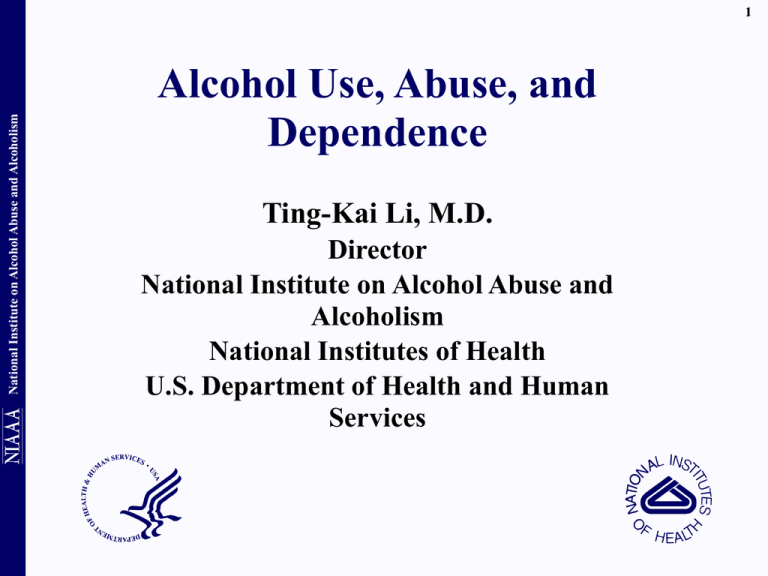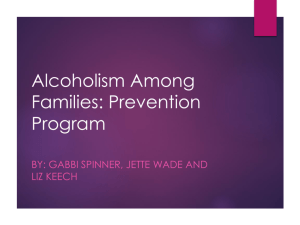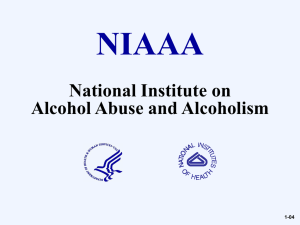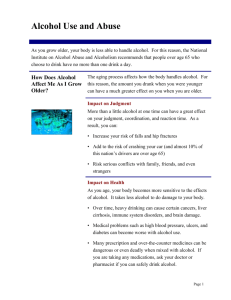Alcohol Use, Abuse, and Dependence
advertisement

National Institute on Alcohol Abuse and Alcoholism 1 Alcohol Use, Abuse, and Dependence Ting-Kai Li, M.D. Director National Institute on Alcohol Abuse and Alcoholism National Institutes of Health U.S. Department of Health and Human Services National Institute on Alcohol Abuse and Alcoholism 2 Ting-Kai Li, M.D. Director National Institute on Alcohol Abuse and Alcoholism http://www.niaaa.nih.gov/AboutNIAAA/DirectorsCorner/default.htm National Institute on Alcohol Abuse and Alcoholism 3 National Institute on Alcohol Abuse and Alcoholism Mission ● increase the understanding of how alcohol use impacts normal and abnormal biological functions and behavior across the lifespan ● improve the diagnosis, prevention, and treatment of alcoholism and other alcohol-related disorders ● enhance quality health care http://pubs.niaaa.nih.gov/publications/StrategicPlan/NIAAASTRATEGICPLAN.htm National Institute on Alcohol Abuse and Alcoholism 4 Alcohol Use 5 National Institute on Alcohol Abuse and Alcoholism Alcohol: Our Most Primitive Intoxicant Egypt (el-Guebaly N, el-Guebaly A, 1981, Int J Addict., 16:120721) barley beer is probably the oldest drink in the world with its origin in Egypt prior to 4200 BC China (McGovern et al., 2004, PNAS, 101:17593-17598) 7000 BC - the production of a prehistoric mixed fermented beverage of rice, honey and fruit (neolithic village of Jiahu in Henan province) 2000 BC- unique cereal beverages (Shang and Western Zhou Dynasties) National Institute on Alcohol Abuse and Alcoholism 6 Ancient Warnings About Alcohol and Harmful Use Through the Ages 1600-1050 BC - Downfall of Egyptian and Chinese Empires and Dynasties attributed to excessive alcohol use 460-320 BC- Grecian Scholars issued advisories on drunkenness and moderate drinking Plato – No use under age 18, between 18-30 use in moderation, no restrictions for use by those older than 40 Aristotle and Hippocrates were both critical of drunkenness 11th Century AD - Simeon Seth, a physician in the Byzantine Court, wrote that drinking wine to excess caused inflammation of the liver, a condition he treated with pomegranate syrup 7 National Institute on Alcohol Abuse and Alcoholism Total Per Capita Consumption in Gallons of Ethanol by State - United States, 2003 ■DC ■ 1.99 or below (10) ■ 2.00-2.24 (15) ■ 2.25-2.49 (16) ■ 2.50 or over (10) 8 65% of the population are drinkers* Males reported drinking 74% and females 26% of all alcohol consumed 73% of the alcohol is consumed by 10% of the population 100 Percent of Consumption National Institute on Alcohol Abuse and Alcoholism Cumulative Distribution of Alcohol Consumption in the United States 80 60 40 20 0 0 10 20 30 40 50 60 70 80 90 100 Percentile Group (High to Low) * Individuals who reported drinking at least one drink in past 12-months NIAAA National Epidemiological Survey on Alcohol and Related Conditions (NESARC) (2001-2002). 9 National Institute on Alcohol Abuse and Alcoholism Drinking Patterns: Rates and Risks Moderate Drinking Most people abstain or drink moderately placing them at low risk for alcohol use disorders. In general, Moderate Drinking is up to 2 drinks/day for men; up to 1 drink/day for women (USDA/HHS Dietary Guidelines, 2005) One drink: one 12- ounce can or bottle of beer or wine cooler , one 5- ounce glass of wine , or 1.5 ounces of 80 - proof distilled spirits . 10 National Institute on Alcohol Abuse and Alcoholism Drinking Patterns: Rates and Risks High-Risk Drinking Nearly 3 in 10 U.S. adults engage in these high-risk drinking patterns1 Men: Women: 1 Source: 2003 more than 14 drinks in a typical week more than 4 drinks on any day more than 7 drinks in a typical week more than 3 drinks on any day NIAAA National Epidemiologic Survey on Alcohol and Related Conditions, 11 National Institute on Alcohol Abuse and Alcoholism Drinking Patterns: Rates and Risks Binge Drinking The National Advisory Council on Alcohol Abuse and Alcoholism has recommended the following definition of Binge Drinking A “binge” is a pattern of drinking alcohol that brings blood alcohol concentration (BAC) to 0.08 gm% or above. For the typical adult, this pattern corresponds to consuming 5 or more drinks (male) or 4 or more drinks (female) in about 2 hours. Binge drinking is clearly dangerous for the drinker and for society 12 National Institute on Alcohol Abuse and Alcoholism U.S. Adult Drinking Patterns and Risks 2001-2002: Odds Ratios Alcohol screening limits—number of drinks: In a typical WEEK—14 (men), 7 (women) On any DAY— 4 (men), 3 (women) The Odds of Having An Alcohol Use Disorder are Increased by a Factor of. . . Percent of U.S. adults aged 18 or older Abuse without dependence Dependence with or without abuse Never exceeds the weekly or daily screening limits 72 % Reference group (1.0) Reference group (1.0) Exceeds only the weekly limit 2% 7.8 12.4 Exceeds only the daily limit less than once a week 14 % 17.0 33.0 Exceeds only the daily limit once a week or more 2% 31.1 82.0 Exceeds both weekly & daily limits once a week or more 10 % 31.1 219.4 Drinking Pattern NIAAA National Survey on Alcohol and Related Conditions, (2001-2002) 13 Harmful Drinking Pattern Across the Lifespan 4.5 Males 4 Females 3.5 3 2.5 Days National Institute on Alcohol Abuse and Alcoholism Number of Days in Past 30 Drank 5 or More Drinks 2 1.5 1 0.5 0 12 13 14 15 16 17 18 19 20 21 22-23 24-25 26-29 30-34 35-49 50-64 65+ Age U.S. Substance Abuse and Mental Health Services Administration, 2003 National Survey on Drug Use and Health (NSDUH) 14 30 25 Relative Risk National Institute on Alcohol Abuse and Alcoholism Relative Risk of an Alcohol-Related Health Condition as a Function of Daily Alcohol Intake 50 g/day 100 g/day 20 15 10 5 0 Oral cavity and pharynx Esophagus Breast Essential hypertension Coronary heart disease Ischemic stroke Condition Adapted from Corrao et al. (2004), Preventive Medicine, 38:613–619 Hemorrhagic Liver cirrhosis Chronic stroke pancreatitis National Institute on Alcohol Abuse and Alcoholism 15 Odds of Co-Occurrence of Current (12-month) DSM-IV Alcohol Dependence and Selected Psychiatric Conditions Disorder Odds Anxiety Disorders 2.6x Mood Disorders (especially Major Depression) 4.1x Personality Disorders 4.0x Antisocial Personality Disorder 7.1x Drug Dependence Nicotine Dependence NIAAA National Epidemiologic Survey on Alcohol and Related Conditions, 2004. 36.9x 6.4x 16 and Abuse on Alcohol Institute National on and National Institute Alcohol Abuse AAlcoholism lcoholism Burden of Disease Attributable to Alcohol Among the 10 Leading Risk Factors for Disease In Developed Countries Tobacco Blood pressure Alcohol Cholesterol Overweight Low fruit and vegetable intake Physical inactivity Illicit drugs Unsafe sex Iron deficiency 0% 2% 4% 6% 8% 10% 12% 14% % Total Number of Health Years Lost to Death/Disability The World Health Report 2002: http://www.who.int/whr/2002/en/whr2002_annex14_16.pdf National Institute on Alcohol Abuse and Alcoholism 17 Alcohol Abuse 18 National Institute on Alcohol Abuse and Alcoholism Definition and Diagnostic Criteria for Alcohol Abuse/ Harmful Use of Alcohol DSM-IV Alcohol Abuse A. A maladaptive pattern of alcohol use leading to clinically significant impairment or distress, as manifested by one or more of the following occurring within a 12-month period: ICD-10 Harmful Use A. A pattern of alcohol use that is causing physical and/or mental damage to health. recurrent drinking resulting in a failure to fulfill major role obligations recurrent drinking in physically hazardous situations* recurrent alcohol-related legal problems continued use despite having persistent or recurrent alcohol-related social or interpersonal problems *Ninety percent of those diagnosed as having Alcohol Abuse endorse this criterion. Others are 20% or less (Dawson, DA. Unpublished NESARC Analysis, 2006) B. The symptoms have never met the criteria for alcohol dependence B. No concurrent diagnosis of the alcohol dependence syndrome 19 National Institute on Alcohol Abuse and Alcoholism Do Alcohol Use Disorders Fall Along a Continuum of Severity? Data from NIAAA’s two general population sample epidemiological studies* and others (e.g., Langenbucher et al., 2004; Krueger et al., 2004; Kahler and Strong, 2006; Saha et al., 2006; Proudfoot et al., 2006) agree that: Alcohol Use Disorders are not bi-axial (abuse and dependence), but fall along a continuum of severity Current criteria for alcohol abuse are not associated only with a milder form of alcohol use disorder; most tap into the more severe end of an alcohol use continuum Current criteria for abuse and dependence contain redundancies * NESARC and the 1991-1992 NIAAA National Longitudinal Alcohol Epidemiological Survey (NLAES) National Institute on Alcohol Abuse and Alcoholism 20 Alcohol Dependence (Alcoholism) 21 Elements of Alcohol Dependence: DSM-IV and ICD-10 National Institute on Alcohol Abuse and Alcoholism (3 of 7 during one year required for diagnosis) 1. Tolerance 2. Withdrawal: relief/avoidance Pharmacological 3. Impaired control* larger/longer unsuccessful attempts to quit/control Maladaptive 4. Compulsive Use* craving (ICD-10) only) neglect activities time spent use despite negative consequences * elements of addiction Severity of Addiction 22 14% 12% One-Year Prevalence National Institute on Alcohol Abuse and Alcoholism Prevalence of Past-year DSM-IV Alcohol Dependence by Age United States, 2001-2002 10% 8% Most people seek treatment at this age 6% 4% Prevalence of DSM-IV Alcohol Dependence in 2001-2002 was 3.8% 2% 0% 12-17 18-20 21-24 25-29 30-34 35-39 40-44 45-49 50-54 55-59 60-64 65-69 Age 18 + yrs. - NIAAA NESARC ( Grant et al. (2004) Drug and Alcohol Dependence, 74:223-234) 12-17 yrs - U.S. Substance Abuse and Mental Health Services Administration 2003 National Survey on Drug Use and Health (NSDUH) National Institute on Alcohol Abuse and Alcoholism 23 Etiology of Alcohol Use Disorders National Institute on Alcohol Abuse and Alcoholism 24 Alcohol use, abuse, and dependence are complex behavioral traits influenced by many factors: genetic and biological responses environmental influences stages of development, from childhood to early adulthood National Institute on Alcohol Abuse and Alcoholism 25 Alcoholism: A Common Complex Disease 26 Developmental Trajectory of AUD National Institute on Alcohol Abuse and Alcoholism Initiation and Continuation of Drinking Initiation of Drinking Progression Alcoholic Drinking Extent of Influence Environmental (familial and non familial) Personality/Temperament (Endophenotype) Pharmacological effects of ethanol (Intermediate Phenotypes) 27 National Institute on Alcohol Abuse and Alcoholism Gene-Environment Interactions in Alcohol Dependence Genes + Environment = different types of alcoholism with different characteristics and levels of severity G11 G22 G33 G44 G55 E11 E22 E33 E44 E55 Alcohol Dependence (Severe) G11 G22 E11 E33 G55 E44 Alcohol Dependence (Moderate) G22 Alcohol Dependence (Mild) G33 G44 E22 E22 E55 National Institute on Alcohol Abuse and Alcoholism 28 Between Individual Variations in Responses to Alcohol (Why drink; Drink more; Drink despite) Pharmacokinetics: absorption, distribution, and metabolism of alcohol 3-4 fold Pharmacodynamics: subjective and objective responses to alcohol 2-3 fold About one-half of these differences is genetic 29 National Institute on Alcohol Abuse and Alcoholism Metabolism of Ethanol and Acetaldehyde in Hepatocyte CYTOSOL ADH ADH CH3CH2OH (mM) ALDH1 ALDH1 CH3COOH (mM) CH3CHO (μM) NAD+ NAD+ NADH NADH CH3COOH (mM) NADH Shuttle ALDH2 ALDH2 CH3CHO CH3COOH NAD+ NAD+ NADH NADH CO2 electron electron transport transport Energy Yield: 7 Kcals/g TCA TCA H2O ATP 30 Percentage in each age group who begin using alcohol National Institute on Alcohol Abuse and Alcoholism Age at Onset: DSM-IV Age of First Use of Alcohol, Nicotine, and Cannabis 35% Age of First Alcohol Use Age at first Nicotine Use 30% Age of First Cannabis Use 25% 20% 15% 10% 5% 0% 5 10 15 20 25 30 35 40 45 Age Source: NIAAA National Epidemiologic Survey on Alcohol and Related Conditions, 2003 50 31 60 1991-1992 2001-2002 60 50 % Prevalence 50 % Prevalence National Institute on Alcohol Abuse and Alcoholism Prevalence of Lifetime Alcohol Dependence by Age of First Alcohol Use and Family History of Alcoholism 40 30 40 30 20 20 10 10 0 0 <=13 13 14 15 16 17 18 19 20 21 14 15 16 17 18 19 20 >=21 Age at First Use of Alcohol Age at First Use of Alcohol Source: Grant and Dawson. (1988). J. Substance Abuse, 10(2):163-73 Source: 2001-2002 National Epidemiologic Survey on Alcohol nad Related Conditions; Laboratory of Epidemiology and Biometry; DICBR, NIAAA, Bethesda, MD. Parental History Positive Total Parental History Negative 32 g/kg/day ( ml/day) Ethanol *p=<0.05 Water (ml/day) National Institute on Alcohol Abuse and Alcoholism Daily Consumption by P and NP Rats Responding on a Two-Bar Operant Task for Water and Different Concentrations of Ethanol Murphy JM, Gatto GJ, McBride WJ, Lumeng L, Li TK ((1989). Alcohol. 6(2):127-31. 2 5 10 15 20 25 % ethanol 30 40 National Institute on Alcohol Abuse and Alcoholism 33 Treatment of Alcohol Use Disorders 34 Many recover, or remit, without professional interventions Early interventions are successful in reducing chronicity and severity Treatment success rates are 30%-60% depending on outcome measure (e.g., abstinence, heavy drinking, social functioning) Past-year Status by Interval Since Onset of Dependence n=4,422 100% Abstainer 90% % PPY Population National Institute on Alcohol Abuse and Alcoholism Treatment of, and Recovery from, Alcohol Dependence 80% 70% Low-risk drinker 60% 50% Asymptomatic risk drinker (subclinical dependence) 40% 30% Partial Remission 20% 10% 0% Still Dependent <5 5 to 9 10 to 19 20+ Interval (Years) Dawson et al., (2005). Addiction. 2005 Mar;100(3):296-8. NIAAA National Epidemiological Survey on Alcohol and Related Conditions, 2001-2002 Interventions include: Brief intervention Behavioral therapies (e.g., motivational enhancement, cognitive behavioral, 12steps) Pharmacological therapies 35 National Institute on Alcohol Abuse and Alcoholism Heterogeneity of Treatment Populations: Severity Screening Prevention Facilitated self-change Brief counseling Behavioral and Medication Therapy Disease management None At-risk* Harmful use * >4 drinks/day, 14 drinks/week (men) >3 drinks/day, 7 drinks/week (women) Dependence (Early) Dependence (Chronic) National Institute on Alcohol Abuse and Alcoholism 36 Clinical Trials in the Last Fifteen Years Have Shown: Different kinds of behavioral therapies work equally well (e.g., motivational enhancement, cognitive behavioral, 12-steps) Naltrexone with Disease Management works and potentially can be used in primary care settings 37 National Institute on Alcohol Abuse and Alcoholism Behavioral Therapies Treatment Intervention Brief intervention Motivational enhancement therapy Primary Target Population(s) High-risk drinkers Alcohol abusers Alcohol- dependent Cognitive behavioral therapy Couples (marital) and family therapies Community reinforcement Selected References: Moyer et al. (2002) Addiction, 97: 279-292; Miller et al. (2002) Addiction, 97: 265-277; O’Farrell et al. (2000) J. Sub.Abuse Treat., 18: 51-54 38 National Institute on Alcohol Abuse and Alcoholism FDA Approved Medications for Treating Alcohol Dependence Medication Target Disulfiram Aldehyde Dehydrogenase Year Approved 1949 Research from animal models over the past 25 years has provided promising targets for pharmacotherapy Naltrexone Mu Opioid Receptor 1994 Acamprosate Glutamate and GABARelated 2004 Naltrexone Depot Mu Opioid Receptor 2006 National Institute on Alcohol Abuse and Alcoholism 39 Medications for Treating Alcohol Dependence – Under Investigation Medication Target Topiramate GABA/Glutamate Valproate GABA/Glutamate Ondansetron 5-HT3 Receptor Nalmefene Mu Opioid Receptor Baclofen GABAB Receptor Antalarmin CRF1 Receptor Rimonabant CB1 Receptor National Institute on Alcohol Abuse and Alcoholism 40 Examples of NIAAA-Supported Clinical Pharmacotherapy Trials for AUDs and Co-morbid Psychiatric Conditions Co-morbidities Medication(s) AD/Depression naltrexone; sertraline AD/Bipolar valproate; naltrexone AUD/anxiety disorders venlafaxine (Effexor) AD/schizophrenia clozapine (Clozaril) AD/tobacco dependence bupropion (Zyban) AD/cocaine dependence topiramate (Topamax) NIAAA Clinician’s Guide National Institute on Alcohol Abuse and Alcoholism Helping Patients Who Drink Too Much Based on the AUDIT-C: 1. How often do you have a drink containing alcohol? 2. How many drinks containing alcohol do you have on a typical day when you are drinking? 3. How often do you have 6 or more drinks on an occasion? The third question alone is: sensitive for heavy drinking (79%) and alcohol abuse/ dependence (81%) specific (83%) for heavy drinking, abuse and dependence1 1 Bush et al, Arch Intern Med. 1998;158:1789-1795 Information and training materials for the NIAAA Clinician’s guide are available at: http://pubs.niaaa.nih.gov/publications/practitioner/CliniciansGuide2005/Guide_Slideshow.htm 41 42 National Institute on Alcohol Abuse and Alcoholism Conclusion: Alcohol Research Strengths and Opportunities Alcohol pharmacogenetics human and animal models Animal models genes, pathways and networks, and GxE interactions Epidemiology longitudinal general population and high-risk studies Treatment behavioral pharmacological





